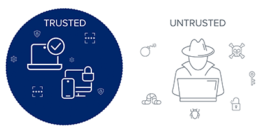Put simply, the term ‘zero trust’ refers to a new approach to security that relies on continuously verifying the trustworthiness of every device, user, and application in an enterprise.
It’s not, however, a set of specific tools or a type of security technology. It is a cybersecurity strategy—a mindset that serves as the foundation of modern security. At the core of a Zero Trust approach is the idea that implicit trust in any single component of a complex, interconnected system can create significant security risks. Instead, trust needs to be established via multiple mechanisms and continuously verified.
3 core principles to the Zero Trust model
- Never trust, always verify
- Assume breach
- Apply least-privileged access

Why use a zero trust model?
Many organizations are adjusting their business models. They’re offering customers new digital experiences they need and want while also enabling a global and disparate workforce.
Applications, users, and devices need fast and secure access to data, so much that an entire industry of security tools and architectures has been built to protect it. Zero trust addresses the security needs of this data-driven hybrid cloud environment. It provides organizations with adaptive and continuous protection for users, data and assets, plus the ability to manage threats proactively. However, it also produces several corollary benefits, such as:
- Enhanced network performance due to reduced traffic on subnets
- Improved ability to address network errors
- More simplified logging and monitoring process due to the granularity
- Quicker breach detection times
How to Implement Zero Trust?
There can be multiple approaches to the model but there are a few considerations almost everyone will need to include in order to implement an efficient Zero Trust architecture:
- Consider the technologies you will need to add to your current stack such as:
- Next Generation Firewall – you will need a tool that provides network protection, decrypts traffic, and can assist with micro-segmentation.
- Zero Trust Network Access – new Zero Trust cloud services can give remote workers access to internal private apps without the complexities, bottlenecks, and risks of VPNs.
- Dara Loss Prevention – DLP solutions enable you to go beyond merely controlling access to managing how your data is used.
- Continues monitoring – to always verify, you need to keep vigilant watch over what people and entities are doing with your systems and data.
- Understand Access Needs – decide who needs access to what in your organization.
- Consider Your Culture – a supportive and educated workforce is key.
More and more organizations are beginning to adopt and implement the Zero Trust model in attempt to better protect their data. With the increase of ransomware demands and the catastrophic damage a data breach can inflict upon an organization, eliminating trust all together is becoming the new norm.
Related Posts
October 14, 2024
Zetta Systems Celebrates 10 Years of Tech Excellence
A Decade of Innovation: Zetta Systems Celebrates 10 Years of Tech Excellence
May 26, 2023
Zetta ISO/IEC Certification
Zetta Systems has successfully implemented the three key integrated management…
May 19, 2023
Zetta Systems joins Bulgarian Cybersecurity Association (BCA)
Cyber security is everyone’s concern and goes beyond discrete security-issue…


